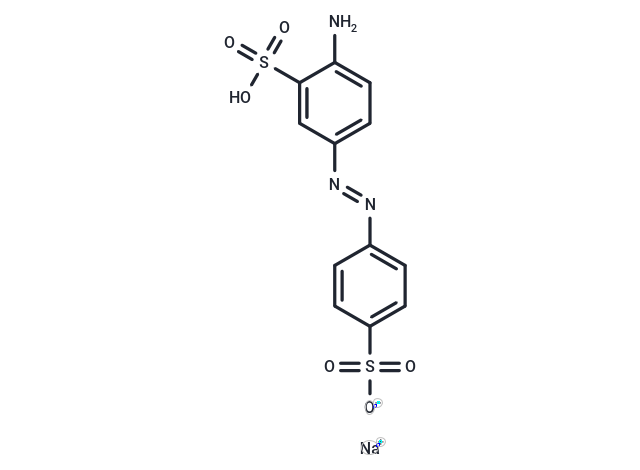Shopping Cart
Remove All Your shopping cart is currently empty
Your shopping cart is currently empty
Acid Yellow 9 monosodium salt (Hydrogen 4-aminoazobenzene-3,4'-disulphonate (sodium salt)) is an azo dye, degraded by Pseudomonas fluorescens as a sole source of nitrogen, carbon, and energy for the bacterium.

| Pack Size | Price | USA Warehouse | Global Warehouse | Quantity |
|---|---|---|---|---|
| 50 mg | $29 | In Stock | In Stock | |
| 1 mL x 10 mM (in DMSO) | $39 | In Stock | In Stock |
| Description | Acid Yellow 9 monosodium salt (Hydrogen 4-aminoazobenzene-3,4'-disulphonate (sodium salt)) is an azo dye, degraded by Pseudomonas fluorescens as a sole source of nitrogen, carbon, and energy for the bacterium. |
| In vitro | I. For bacterial degradation studies 1. Cultivate bacteria: Cultivate Pseudomonas fluorescens in a suitable nutrient medium. 2. Add dye: Add Acid Yellow 9 monosodium salt (usually at a concentration of 50-200 mg/L) to the medium to provide the dye as the only source of carbon and nitrogen. 3. Cultivate: Cultivate at a suitable growth temperature (usually 30-37°C) and monitor bacterial growth and dye degradation. 4. Monitor degradation: Use an ultraviolet-visible spectrophotometer (UV-Vis) or liquid chromatography (HPLC) to detect the reduction in dye concentration or degradation products. II. For bioremediation studies 1. Contaminated water sample: Prepare wastewater or water sample containing Acid Yellow 9 with a known dye concentration. 2. Inoculate bacteria: Inoculate Pseudomonas fluorescens or other suitable microorganisms into the wastewater. 3. Monitor degradation: Regularly monitor the degradation of Acid Yellow 9 and track changes in dye concentration using a spectrophotometer or chromatography. 4. Evaluation of remediation effect: Evaluate the effect of microbial treatment by analyzing the degradation of dyes and comparing with control samples. III. For environmental toxicity testing: 1. Toxicity test: Expose different concentrations of Acid Yellow 9 monosodium salt to Pseudomonas fluorescens or other environmental microorganisms to monitor bacterial growth and metabolic activity. 2. Biodegradation evaluation: Evaluate the degradation ability and growth of microorganisms in the presence of the dye by tracking changes in dye concentration. IV. For dye and pigment research 1. Dye exposure study: Expose different concentrations of Acid Yellow 9 monosodium salt to microbial culture medium to study the degradation pathway of microorganisms. 2. Enzyme activity analysis: Use enzyme activity assay to evaluate the enzyme system of bacteria that decompose dyes and further explore its degradation mechanism. |
| Synonyms | Hydrogen 4-aminoazobenzene-3,4'-disulphonate (sodium salt) |
| Molecular Weight | 379.34 |
| Formula | C12H10N3NaO6S2 |
| Cas No. | 74543-21-8 |
| Smiles | [Na+].Nc1ccc(cc1S(=O)(=O)O)\N=N\c2ccc(cc2)S(=O)(=O)[O-] |
| Relative Density. | no data available |
| Color | Orange |
| Appearance | Solid |
| Storage | keep away from direct sunlight | Powder: -20°C for 3 years | In solvent: -80°C for 1 year | Shipping with blue ice/Shipping at ambient temperature. | |||||||||||||||||||||||||||||||||||
| Solubility Information | DMSO: 55 mg/mL (144.99 mM), Sonication is recommended. | |||||||||||||||||||||||||||||||||||
Solution Preparation Table | ||||||||||||||||||||||||||||||||||||
DMSO
| ||||||||||||||||||||||||||||||||||||
| Size | Quantity | Unit Price | Amount | Operation |
|---|

Copyright © 2015-2026 TargetMol Chemicals Inc. All Rights Reserved.